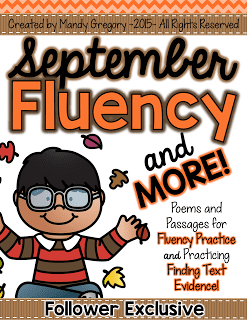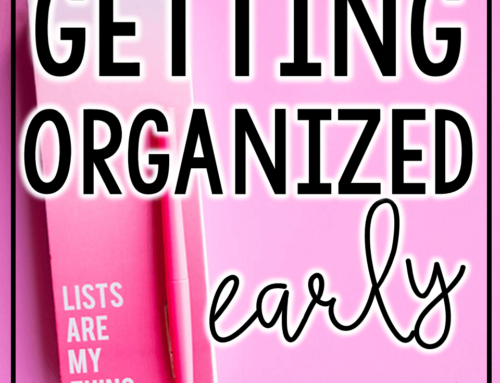Yesterday we talked about what fluency is and what it is not and the WHY we should be teaching it explicitly. Today we are going to dive into the meat and potatoes: the actual strategies for practicing fluency!
What Does the Research Say?
1.) assistive reading
2.) repeated readings
Two of the articles (this one and this one ) I read mentioned “assistive strategies.” I had not heard this term, but after reading about it in the articles, it reminded me of a combination of familiar strategies.
I know all of us have used repeated readings- especially with some assessments.
So, how can we apply these in the classroom- quickly and easily?
The article said, “After reading a passage aloud to students, I ask them to follow along with me, first silently and then aloud, as a group. Sometimes I ask students to orally read a passage with a partner who is at the same reading level. At other times, I ask more fluent readers to read with students who are having difficulty with reading (Eldredge & Quinn, 1988; Topping, 1987a, 1987b, 1995) or I have students silently read while listening to a fluent rendering of the passage on tape (Carbo, 1978; Pluck, 1995). Such practices constitute a powerful strategy for improving fluency and comprehension.”
How Can I Apply This in My Classroom?
We can use assisted reading:
- to model fluent reading while the teacher (or a good model) reads aloud
- have students echo read with a good model
- read aloud to partners
- listen to fluent readers on tape
Many of you may already do this in partner readings (Daily Five really emphasizes this) and a listening center.
Another article cited the use of repeated readings. The article stated, “”I don’t think even today there’s much evidence we have a replacement for that,” said David J. Chard, the dean of the Annette Caldwell Simmons School of Education and Human Development at Southern Methodist University in Dallas. All the proven strategies “at their root involve a model and some kind of repeated reading. Teachers often follow that practice by sitting with students one-on-one and timing them as they read the same short passage several times, or until they reach an acceptable fluency level….The caveat for timed repeated reading, some say, is that it can lead to a focus on rate at the expense of expression and comprehension.“
How Can I Apply This in My Classroom?
We can use repeated reading:
- to model a fluent reading first
- ask students to echo read
- have students read a piece of text multiple times to a partner
- use this as an assessment piece
- practice for performance pieces
My kids always LOVED performing. They were such sweet little hams! Readers Theater has long been known to be a creative way to practice fluency in the classroom.One year my students did a reader’s theater EVERY week for several months. They loved it! You can read about how I “fit it all in” each week here.
What are Some Resources for Repeated Readings?
The hardest part about completing repeating readings is finding quality resources. A few years I came across a really neat idea for practicing fluency called The Great Poetry Race. You can read about it here. It was pretty successful in my classroom! On that page you can also find several FREE, printable poems that are seasonal.
Poems work really well for repeated readings because they are typically short and not time consuming.
I just finished this September Fluency and more! pack. It is full of leveled (beginning or mid 2nd grade levels) passages that match September topics (football, the Constitution, Seasons of an Apple Tree, How to Make Apple Stamps, Grandparents Day). It also includes running records for assessing fluency and poems. I wanted to make sure teachers got plenty of “bang for their buck” with the same passage. I also included questions for students to practicing finding evidence in the text.
If you want to try it first, check out this exclusive!
Tips for Using Repeated Readings in the Classroom
If you want your students to practice repeating readings in the classroom, you may want to provide whisper phones. Otherwise the noise may get…just, gah!
Kristin from School in the City shared a post on how to make them CHEAPLY!
I love this freebie from Amanda at Mrs. Richardson’s Class!
They are simple rubrics- even easy enough for the littles, where students can rate themselves. I love that it hits the biggies, such as expression and reading at a conversational rate- all in kid friendly terms.
Do you practice fluency in your classroom? How do you practice?
I hope this post gave some tips and tricks! If you would like more ideas from me, be sure to follow me on Teachers Pay Teachers, Pinterest, and Facebook to catch all the freebies and ideas and more!
Mandy Gregory is a 2007 and 2012 Teacher of the Year. She has taught Kindergarten- 4th grades in both the general education and inclusion settings. She is currently a 1st grade Special Education teacher. She is the owner and creator of Mandy’s Tips for Teachers website (www.mandystipsforteachers.com) and has over 13 years of teaching experience. She is married with two beautiful children.













I checked out the sample and was so excited I'm buying the pack! I hope you create more like this, such a great resource. 🙂
Yahoo! I am so glad you liked it Rebecca! I will begin working on October soon, so if there is something you need please just let me know!!!
Love this information. I am an ESL teacher so I always try to sneak in extra repeated readings. I think that the emphasis common core places on close reading really pairs well with repeated readings for fluency. We ask them to reread for a variety of purposes– some for comprehension, some for word study, and some for fluency.
My Bright Blue House
This is a super resource. I Downloaded the sample and it looks great, so I'm heading over to buy it! Will you be adding more? Making a bundle maybe?
I love the"Great Poetry Race" too. I'd like to try it out in my classroom. Sadly all the links to the poems from that page are broken, though.
Always Primary
Thank you so much Debbie! My goal is to make more, but I don't want to commit to a bundle yet. Bundles make me nervous! LOL! Eek! I had no idea that the poem links were broken. Thank you so much for letting me know. I may not be able to fix that (software issues), but I am recreating and updating the site on WordPress. Hopefully I will get it up by Christmas. Then I can include the correct links!!!